Ram Shankar Tripathi | |
|---|---|
| Born | 15 October 1929 Sodalpur, Madhya Pradesh, India |
| Died | 18 February 2019 (aged 89) |
| Occupation(s) | Scholar of Buddhism, Sanskrit, Pali |
| Awards | Padma Shri |
Ram Shankar Tripathi (15 October 1929 - 18 February 2019) was an Indian scholar of Buddhism, editor and author of many texts focusing on Buddhist philosophy and Buddhist Tantra. Partly inspired by Jagannath Upadhyaya, Ram Shankar Tripathi had been instrumental in reviving the study of Buddhist texts among Sanskritists in India and abroad, having taught a vast number of scholars from different parts of the world, and through a long-lasting association with traditional Buddhist scholars, from Tibet, Burma and elsewhere. Much of the important editorial work from the CUTS (former CIHTS) in Sarnath was encouraged and supported by Ram Shankar Tripathi's guidance; several prominent Tibetan Lamas, as well as a good number of contemporary Buddhologists, had studied with him.
He was the former Dean of the Faculty of Śabdavidyā at the Central University of Tibetan Studies. [1] He served as the Head of the Department of Bauddhadarśana at the Sampurnanand Sanskrit University. [2] He is also associated with the Savitribai Phule Pune University, where he was a visiting faculty of Pali and Buddhist Studies. [3] He was the author of several books in Hindi and Sanskrit, including Sautrāntikadarśanam, [4] and edited Dalai Lama's The Path to Tranquility: Daily Meditations, [5] among others. [6] Hevajratantram: With Muktāvalī Pañjikā of Mahāpaṇḍitācārya Ratnākaraśānti [7] and Jainavidyā evaṃ Prākr̥ta [8] are two of his other notable works. His most recent publication is a Sanskrit commentary on the Pramāṇavārttika, Chapter I, offering a comprehensive guide to Dharmakīrti's difficult verses, and being more accessible than the ancient commentaries.
The Government of India awarded him the fourth highest civilian honour of the Padma Shri, in 2009, for his contributions to Literature and Education. [9]
On 18 February 2019, he died at the age of 90. [10]

Tibetan Buddhism is a form of Buddhism practiced in Tibet, Bhutan and Mongolia. It also has a sizable number of adherents in the areas surrounding the Himalayas, including the Indian regions of Ladakh, Sikkim, and Arunachal Pradesh, as well as in Nepal. Smaller groups of practitioners can be found in Central Asia, Xinjiang, Inner Mongolia, and some regions of Russia, such as Tuva, Buryatia, and Kalmykia.
The Bodhisattvacaryāvatāra or Bodhicaryāvatāra translated into English as A Guide to the Bodhisattva's Way of Life, is a Mahāyāna Buddhist text written c. 700 AD in Sanskrit verse by Shantideva (Śāntideva), a Buddhist monk at Nālandā Monastic University in India which is also where it was composed.
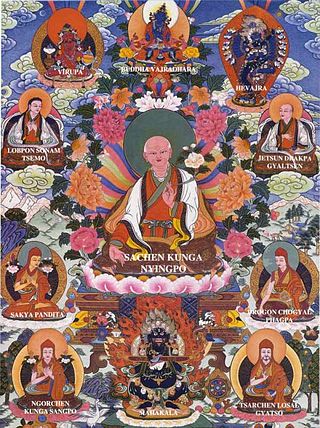
The Sakya school is one of four major schools of Tibetan Buddhism, the others being the Nyingma, Kagyu, and Gelug. It is one of the Red Hat Orders along with the Nyingma and Kagyu.

Mahāmudrā literally means "great seal" or "great imprint" and refers to the fact that "all phenomena inevitably are stamped by the fact of wisdom and emptiness inseparable". Mahāmudrā is a multivalent term of great importance in later Indian Buddhism and Tibetan Buddhism which "also occurs occasionally in Hindu and East Asian Buddhist esotericism."
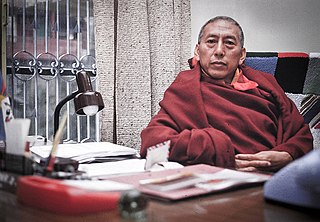
Lobsang Tenzin, better known by the titles Professor Venerable Samdhong Rinpoche and to Tibetans as the 5th Samdhong Rinpoche, is a Tibetan Buddhist monk and politician who served as the Prime Minister of the cabinet of the Central Tibetan Administration, the Tibetan government-in-exile based in Dharamshala, India.
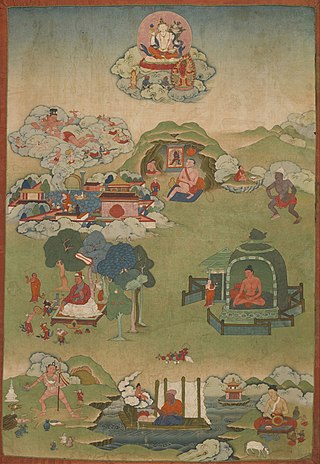
Tibetan tantric practice, also known as "the practice of secret mantra", and "tantric techniques", refers to the main tantric practices in Tibetan Buddhism. The great Rime scholar Jamgön Kongtrül refers to this as "the Process of Meditation in the Indestructible Way of Secret Mantra" and also as "the way of mantra," "way of method" and "the secret way" in his Treasury of Knowledge. These Vajrayāna Buddhist practices are mainly drawn from the Buddhist tantras and are generally not found in "common" Mahayana. These practices are seen by Tibetan Buddhists as the fastest and most powerful path to Buddhahood.

The roots of Buddhism in Poland can be found in the early 20th century in the nation's connections to the origin countries of the religion, like Vietnam, China, Japan, and Korea. After World War II, primarily expatriate Poles joined various Buddhist groups and organizations. Since the breakdown of the Eastern Bloc, which had promoted an antireligious campaign, Buddhism has been able to develop further in the more tolerant atmosphere.

Glenn H. Mullin is a Tibetologist, Buddhist writer, translator of classical Tibetan literature and teacher of Tantric Buddhist meditation.

In Tibetan Buddhism, the Three Jewels and Three Roots are supports in which a Buddhist takes refuge by means of a prayer or recitation at the beginning of the day or of a practice session. The Three Jewels are the first and the Three Roots are the second set of three Tibetan Buddhist refuge formulations, the Outer, Inner and Secret forms of the Three Jewels. The 'Outer' form is the 'Triple Gem', the 'Inner' is the Three Roots and the 'Secret' form is the 'Three Bodies' or trikāya of a Buddha.

Bruce Alan Wallace is an American author and expert on Tibetan Buddhism. His books discuss Eastern and Western scientific, philosophical, and contemplative modes of inquiry, often focusing on the relationships between science and Buddhism. He is founder of the Santa Barbara Institute for Consciousness Studies.

The Central Institute of Higher Tibetan Studies, formerly called Central University for Tibetan Studies (CUTS), is a Deemed University founded in Sarnath, Varanasi, India, in 1967, as an autonomous organisation under Union Ministry of Culture. The CIHTS was founded by Pt. Jawahar Lal Nehru in consultation with Tenzin Gyatso, the 14th Dalai Lama, with the aim of educating Tibetan youths in exile and Himalayan border students as well as with the aim of retranslating lost Indo-Buddhist Sanskrit texts that now existed only in Tibetan, into Sanskrit, to Hindi, and other modern Indian languages.
Khunu Lama Tenzin Gyaltsen, 1894–1977, known also as Negi Lama Tenzin Gyaltsen, Tenzin Gyaltsen, and various other names like Kunu Rinpoche, Kunu Lama and Negi Lama, was born in 1894 in the village of Sunam which lies in the Kinnaur district of India in the western Himalayas. He passed away at the age of 82 at Shashur Monastery in the Lahaul and Spiti district of Himachel Pradesh on February 23, 1977, while teaching the final page of Gampopa's Jewel Ornament of Liberation. Khunu Rinpoche was not officially recognized as a tulku, nor was he an ordained Buddhist monk, but a layman who had taken lay practitioner's vows before becoming a Tibetan Buddhist master.

The 14th Dalai Lama is, as the incumbent Dalai Lama, the highest spiritual leader and head of Tibetan Buddhism. By the adherents of Tibetan Buddhism, he is considered a living Bodhisattva; specifically, an emanation of Avalokiteśvara in Sanskrit, and Chenrezig in Tibetan. He is also the leader and a monk of the Gelug school, the newest school of Tibetan Buddhism, formally headed by the Ganden Tripa. The central government of Tibet at the time of his selection, the Ganden Phodrang, invested the Dalai Lama with temporal duties until his exile in 1959.
There is a small Mongolian community in India, comprising mostly Buddhist monks and scholars as well as international students from Mongolia.

Kyabje Yongzin Ling Rinpoche is a Tibetan tulku. The best-known incarnation is the sixth incarnation, Thupten Lungtok Namgyal Thinley, a Tibetan buddhist scholar and teacher.
Geshe Acharya Thubten Loden was the spiritual leader of the Tibetan Buddhist Society in Australia. Geshe Loden established the Peaceful Land of Joy Meditation Centre in Yuroke, Victoria, and has written many books. In 2011, he was named Hume Citizen of the Year.
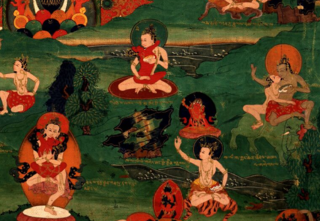
Karmamudrā is a Vajrayana Buddhist technique which makes use of sexual union with a physical or visualized consort as well as the practice of inner heat (tummo) to achieve a non-dual state of bliss and insight into emptiness. In Tibetan Buddhism, proficiency in inner heat yoga is generally seen as a prerequisite to the practice of karmamudrā.

Ratnākaraśānti was an influential Buddhist philosopher and vajrayana tantric adept and scholar. He was the "gate scholar" of Vikramaśilā university's eastern gate, a key post in the university's leadership. Ratnākara was known by the title kalikālasarvajña and is depicted as one of the eighty-four mahāsiddhas.
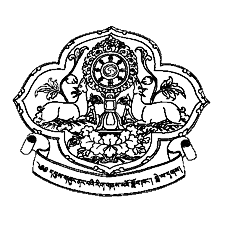
The Central Institute of Buddhist Studies, formerly known as the School of Buddhist Philosophy, located in Leh town of Ladakh is a deemed university under Ministry of Culture. It was founded in 1959 and formerly affiliated to the Sampurnanand Sanskrit University in Varanasi.
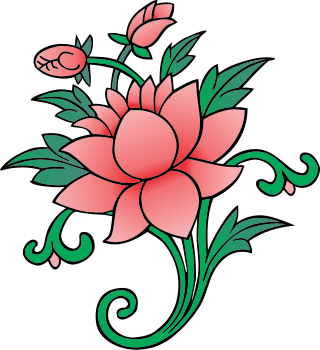
The Bhāvanākrama is a set of three Buddhist texts written in Sanskrit by the Indian Buddhist scholar yogi Kamalashila of Nalanda university. These works are the principal texts for mental development and the practice of shamatha and vipashyana in Tibetan Buddhism and have been "enormously influential". The texts survive in full Tibetan translation, part 1 and 3 also survive in Sanskrit. The Bhāvanākramas are also one of the favorite texts of the 14th Dalai Lama, who has translated and written a commentary on the middle Bhk.